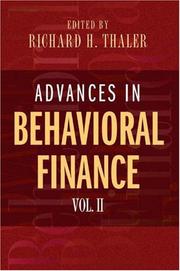| Listing 1 - 10 of 12 | << page >> |
Sort by
|
Book
Year: 1993 Publisher: Cambridge, Mass. National Bureau of Economic Research
Abstract | Keywords | Export | Availability | Bookmark
 Loading...
Loading...Choose an application
- Reference Manager
- EndNote
- RefWorks (Direct export to RefWorks)
Book
ISBN: 110158033X Year: 2012 Publisher: [Place of publication not identified] Portfolio/Penguin
Abstract | Keywords | Export | Availability | Bookmark
 Loading...
Loading...Choose an application
- Reference Manager
- EndNote
- RefWorks (Direct export to RefWorks)
Finance, Personal --- Pension trusts --- Individual retirement accounts --- Psychological aspects --- Investments
Book
ISBN: 069819585X Year: 2015 Publisher: [Place of publication not identified] Portfolio Penguin
Abstract | Keywords | Export | Availability | Bookmark
 Loading...
Loading...Choose an application
- Reference Manager
- EndNote
- RefWorks (Direct export to RefWorks)
Retirement --- Retirees --- Planning
Book
ISBN: 0698194306 Year: 2015 Publisher: New York : Penguin Publishing Group,
Abstract | Keywords | Export | Availability | Bookmark
 Loading...
Loading...Choose an application
- Reference Manager
- EndNote
- RefWorks (Direct export to RefWorks)
A leading behavioral economist reveals the tools that will improve our decision making on screensOffice workers spend the majority of their waking hours staring at screens. Unfortunately, few of us are aware of the visual biases and behavioral patterns that influence our thinking when we're on our laptops, iPads, smartphones, or smartwatches. The sheer volume of information and choices available online, combined with the ease of tapping buy, often make for poor decision making on screens.In The Smarter Screen, behavioral economist Shlomo Benartzi reveals a tool kit of interventions for the digital age. Using engaging reader exercises and provocative case studies, Benartzi shows how digital designs can influence our decision making on screens in all sorts of surprising ways. For example: You're more likely to add bacon to your pizza if you order online. If you read this book on a screen, you're less likely to remember its content. You might buy an item just because it's located in a screen hot spot, even if better options are available. If you shop using a touch screen, you'll probably overvalue the product you're considering. You're more likely to remember a factoid like this one if it's displayed in an ugly, difficult-to-read font. Drawing on the latest research on digital nudging, Benartzi reveals how we can create an online world that helps us think better, not worse.From the Hardcover edition.
Book
Year: 1993 Publisher: Cambridge, Mass. National Bureau of Economic Research
Abstract | Keywords | Export | Availability | Bookmark
 Loading...
Loading...Choose an application
- Reference Manager
- EndNote
- RefWorks (Direct export to RefWorks)
Book
Year: 1993 Publisher: Cambridge, Mass. National Bureau of Economic Research
Abstract | Keywords | Export | Availability | Bookmark
 Loading...
Loading...Choose an application
- Reference Manager
- EndNote
- RefWorks (Direct export to RefWorks)
The equity premium puzzle, first documented by Mehra and Prescott, refers to the empirical fact that stocks have greatly outperformed bonds over the last century. As Mehra and Prescott point out, it appears difficult to explain the magnitude of the equity premium within the usual economics paradigm because the level of risk aversion necessary to justify such a large premium is implausibly large. We offer a new explanation based on Kahneman and Tversky's 'prospect theory'. The explanation has two components. First, investors are assumed to be 'loss averse' meaning they are distinctly more sensitive to losses than to gains. Second, investors are assumed to evaluate their portfolios frequently, even if they have long-term investment goals such as saving for retirement or managing a pension plan. We dub this combination 'myopic loss aversion'. Using simulations we find that the size of the equity premium is consistent with the previously estimated parameters of prospect theory if investors evaluate their portfolios annually. That is, investors appear to choose portfolios as if they were operating with a time horizon of about one year. The same approach is then used to study the size effect. Preliminary results suggest that myopic loss aversion may also have some explanatory power for this anomaly.
Risk --- Stocks --- Economic development --- Prices. --- Mathematical models.
Book

ISBN: 9781400829118 Year: 2011 Publisher: Princeton, NJ
Abstract | Keywords | Export | Availability | Bookmark
 Loading...
Loading...Choose an application
- Reference Manager
- EndNote
- RefWorks (Direct export to RefWorks)
Book

ISBN: 9781400829125 Year: 2005 Publisher: Princeton, NJ
Abstract | Keywords | Export | Availability | Bookmark
 Loading...
Loading...Choose an application
- Reference Manager
- EndNote
- RefWorks (Direct export to RefWorks)
Digital

ISBN: 9781400829118 9780691116822 Year: 2011 Publisher: Princeton, N.J. Princeton University Press
Abstract | Keywords | Export | Availability | Bookmark
 Loading...
Loading...Choose an application
- Reference Manager
- EndNote
- RefWorks (Direct export to RefWorks)


ISBN: 9781400829125 9780691121741 Year: 2005 Publisher: Princeton, N.J. Princeton University Press
Abstract | Keywords | Export | Availability | Bookmark
 Loading...
Loading...Choose an application
- Reference Manager
- EndNote
- RefWorks (Direct export to RefWorks)
| Listing 1 - 10 of 12 | << page >> |
Sort by
|

 Search
Search Feedback
Feedback About UniCat
About UniCat  Help
Help News
News